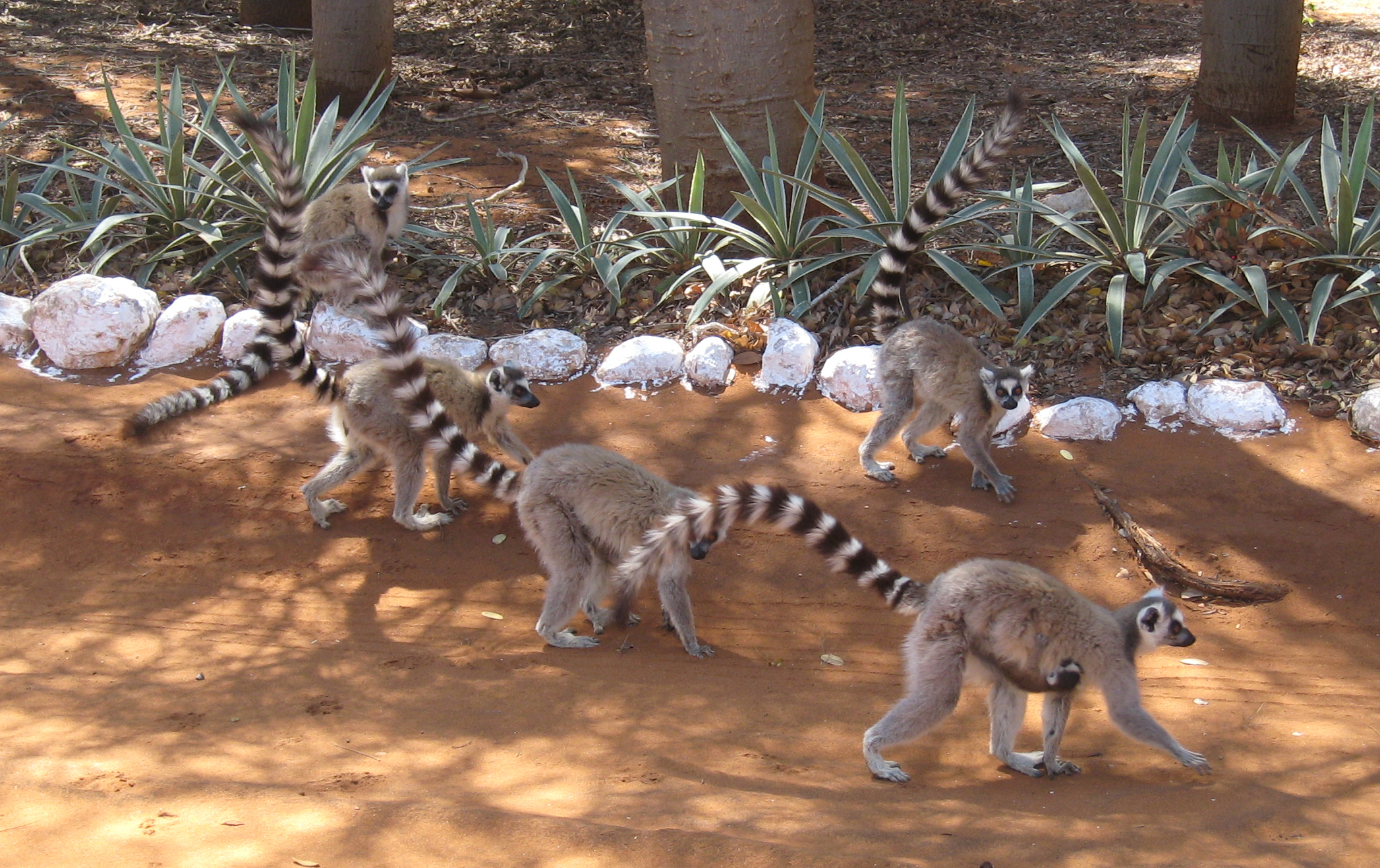|
White-footed Sportive Lemur
The white-footed sportive lemur, white-footed weasel lemur, or dry-bush weasel lemur (''Lepilemur leucopus'') is a species of lemur in the family Lepilemuridae, the sportive lemurs. It is similar in appearance to other lemurs in the family, with a grey back, a pale grey to white ventral side, and a light brown tail. It is a nocturnal animal that moves through the forest using a vertical clinging and leaping technique. It is endemic to Madagascar, inhabiting the southern subtropical or tropical dry shrubland. It is threatened by habitat loss due to agriculture practices and charcoal production. Behaviour Diet This sportive lemur eats mainly leaves. During the dry season around Berenty, it may depend entirely on the leaves and flowers of ''Alluaudia'' species. This lemur is coprophagous, consuming and redigesting its feces to further breakdown of the cellulose contained in it. Social systems The basic social unit of this species is a mother and her offspring. Males live in soli ... [...More Info...] [...Related Items...] OR: [Wikipedia] [Google] [Baidu] |
Charles Immanuel Forsyth Major
Charles Immanuel Forsyth Major (15 August 1843, Glasgow – 25 March 1923, Munich) was a Scottish-born, Swiss physician, zoologist and vertebrate palaeontologist. Major was born in Glasgow and studied at Basel and Zurich Universities in Switzerland and later Göttingen in Germany. He graduated in medicine at Basel in 1868 and became a physician in Florence, Italy. Like many early naturalists he spent his free time studying fossil mammals. His first publication was on fossil primates in 1872. The Italian government supported him in 1877 and he collected fossils from Calabria, Corsica, Sardinia, and Sicily. In 1886, he stopped practising as a physician and began to study fossils in the Greek Archipelago with his collections going to the College Galliard at Lausanne and to the British Museum (Natural History). In the British Museum collections he took a keen interest in material from Madagascar. He studied the lemur fauna, both extant and extinct, discovered the new family Megaladap ... [...More Info...] [...Related Items...] OR: [Wikipedia] [Google] [Baidu] |
Madagascar Spiny Thickets
The Madagascar spiny forests (also known as the Madagascar spiny thickets) is an ecoregion in the southwest of Madagascar. The vegetation type is found on poor substrates with low, erratic winter rainfall. The ecoregion contains an outstanding proportion of endemic plant species and is listed as one of the 200 most important ecological regions in the world; one of the Global 200. Flora This is the area with the highest level of plant endemism in Madagascar, with 48% of the genera and 95% of the species endemic.Elmqvist T, Pyyko ̈nen M, Tengo ̈M, Rakotondrasoa F, Rabakonandrianina E, et al (2007) Patterns of Loss and Regeneration of Tropical DryForest in Madagascar: The Social Institutional Context. PLoS ONE 2(5): e402. doi:10.1371 Many constituent plants show extreme adaptations to drought. Spiny plants of the endemic subfamily Didiereoideae form a conspicuous component, especially towards the east. They are woody but distantly related to the cacti. The remaining component of th ... [...More Info...] [...Related Items...] OR: [Wikipedia] [Google] [Baidu] |
Mammals Described In 1894
Mammals () are a group of vertebrate animals constituting the class Mammalia (), characterized by the presence of mammary glands which in females produce milk for feeding (nursing) their young, a neocortex (a region of the brain), fur or hair, and three middle ear bones. These characteristics distinguish them from reptiles (including birds) from which they diverged in the Carboniferous, over 300 million years ago. Around 6,400 extant species of mammals have been described divided into 29 orders. The largest orders, in terms of number of species, are the rodents, bats, and Eulipotyphla (hedgehogs, moles, shrews, and others). The next three are the Primates (including humans, apes, monkeys, and others), the Artiodactyla (cetaceans and even-toed ungulates), and the Carnivora (cats, dogs, seals, and others). In terms of cladistics, which reflects evolutionary history, mammals are the only living members of the Synapsida (synapsids); this clade, together with Sauropsida ... [...More Info...] [...Related Items...] OR: [Wikipedia] [Google] [Baidu] |
Sportive Lemurs
A cyclosportive, or often simply sportive, is a short to long distance, organised, mass-participation cycling event, typically held annually. The Italian term '' Gran Fondo'' is commonly used for these events in the United States, Australia and some other English-speaking countries. ''Cyclosportive'' is short for the French term french: label=none, randonnée cyclosportive (the spelling cyclosportif is sometimes also used but ''cyclosportive'' is correct as ''randonnée'' is a feminine noun in French). Many cyclists use sportives to challenge themselves in a personal battle against the distance and then ultimately, the clock. Some participants in a cyclosportive will ride the event like a race, with prizes awarded and considerable prestige for top place finishers, particularly in events like La Marmotte, L'Étape du Tour and the Ardechoise. A cyclosportive falls between a traditional cycle road race and the more challenging non-competitive randonnée or Audax events. Riders ... [...More Info...] [...Related Items...] OR: [Wikipedia] [Google] [Baidu] |
Andohahela National Park
Andohahela National Park, in south-east Madagascar, is remarkable for the extremes of habitats that are represented within it. The park covers of the Anosy mountain range, the southernmost spur of the Malagasy Highlands and contains the last humid rainforests in the southern part of Madagascar. The Park was inscribed in the World Heritage Site in 2007 as part of the Rainforests of the Atsinanana. History Andohahela has been a protected area since 1939 but did not become a national park until 1998. Geography Andohahela National Park is north-west of Tôlanaro and at the southern end of the Malagasy Highlands. The park is divided into three zones. The first, Malio, ranges from to the summit of Pic d' Andohahela at , and has dense lowland and montane rainforest with more than two hundred species of tree ferns, orchids, wild vanilla, lemurs and many birds. The second, Ihazofotsy-Mangatsiaka, contains dry spiny forest with rare birds and reptiles in altitudes ranging from to at ... [...More Info...] [...Related Items...] OR: [Wikipedia] [Google] [Baidu] |
Data Deficient
A data deficient (DD) species is one which has been categorized by the International Union for Conservation of Nature (IUCN) as offering insufficient information for a proper assessment of conservation status to be made. This does not necessarily indicate that the species has not been extensively studied; but it does indicate that little or no information is available on the abundance and distribution of the species. The IUCN recommends that care be taken to avoid classing species as "data deficient" when the absence of records may indicate dangerously low abundance: "If the range of a taxon is suspected to be relatively circumscribed, if a considerable period of time has elapsed since the last record of the taxon, threatened status may well be justified""The Categories," in IUCN (1983). (see also precautionary principle). See also * IUCN Red List data deficient species * List of data deficient amphibians * IUCN Red List data deficient species (Annelida) * List of data deficien ... [...More Info...] [...Related Items...] OR: [Wikipedia] [Google] [Baidu] |
Conservation Status
The conservation status of a group of organisms (for instance, a species) indicates whether the group still exists and how likely the group is to become extinct in the near future. Many factors are taken into account when assessing conservation status: not simply the number of individuals remaining, but the overall increase or decrease in the population over time, breeding success rates, and known threats. Various systems of conservation status exist and are in use at international, multi-country, national and local levels as well as for consumer use. International systems IUCN Red List of Threatened Species The IUCN Red List of Threatened Species is the best known worldwide conservation status listing and ranking system. Species are classified by the IUCN Red List into nine groups set through criteria such as rate of decline, population size, area of geographic distribution, and degree of population and distribution fragmentation. Also included are species that have gone ext ... [...More Info...] [...Related Items...] OR: [Wikipedia] [Google] [Baidu] |
International Union For Conservation Of Nature
The International Union for Conservation of Nature (IUCN; officially International Union for Conservation of Nature and Natural Resources) is an international organization working in the field of nature conservation and sustainable use of natural resources. It is involved in data gathering and analysis, research, field projects, advocacy, and education. IUCN's mission is to "influence, encourage and assist societies throughout the world to conserve nature and to ensure that any use of natural resources is equitable and ecologically sustainable". Over the past decades, IUCN has widened its focus beyond conservation ecology and now incorporates issues related to sustainable development in its projects. IUCN does not itself aim to mobilize the public in support of nature conservation. It tries to influence the actions of governments, business and other stakeholders by providing information and advice and through building partnerships. The organization is best known to the wider pu ... [...More Info...] [...Related Items...] OR: [Wikipedia] [Google] [Baidu] |
Berenty Private Reserve
Berenty Reserve is a small private reserve of gallery forest along the Mandrare River, set in the semi-arid spiny forest ecoregion of the far south of Madagascar. For more than three decades the late primatologist Alison Jolly (who started the research at Berenty), other researchers and students have visited Berenty to conduct fieldwork on lemurs. The reserve is also a favourite for visitors who want to see some of Madagascar's endemic bird species, which include owls and couas. The reserve has accommodation in the forest and a set of forest trails to explore. It attracts the most visitors of any Madagascar nature reserve. It is reached after a two-hour drive from Tôlagnaro on the southeast coast. See also * List of national parks of Madagascar * Madagascar spiny thickets The Madagascar spiny forests (also known as the Madagascar spiny thickets) is an ecoregion in the southwest of Madagascar. The vegetation type is found on poor substrates with low, erratic winter rainfall. ... [...More Info...] [...Related Items...] OR: [Wikipedia] [Google] [Baidu] |
Mandrare River
''Mandrare '' is a river in the region of Anosy in southern Madagascar. It flows into the Indian Ocean near Amboasary Sud. It becomes dry in certain months of the year. See also *List of rivers of Madagascar This is a list of streams and rivers in Madagascar A Andranotsimisiamalona River - Ankavanana - Antainambalana River B Bemarivo River - Besokatra River - Betsiboka River - Bombetoka River F Fanambana River - Faraony River - Fiheren ... References Rivers of Anosy Rivers of Madagascar {{Madagascar-river-stub ... [...More Info...] [...Related Items...] OR: [Wikipedia] [Google] [Baidu] |
Menarandra River
Menarandra is a river in the regions of Androy and Atsimo-Andrefana in southern Madagascar. It flows into the Indian Ocean near Bevoalavo Est. Its annual discharge is low, approx. 2-3 L/s/km at Tranoroa. References Rivers of Atsimo-Andrefana Rivers of Madagascar {{Madagascar-river-stub ... [...More Info...] [...Related Items...] OR: [Wikipedia] [Google] [Baidu] |
Gallery Forest
A gallery forest is one formed as a corridor along rivers or wetlands, projecting into landscapes that are otherwise only sparsely treed such as savannas, grasslands, or deserts. The gallery forest maintains a more temperate microclimate above the river. Defined as long and narrow forest vegetation associated with rivers, gallery forests are structurally and floristically heterogeneous. The habitats of these forests differ from the surrounding landscapes because they are, for example, more nutrient-rich or moister and/or there is less chance of fires. The forests are sometimes only a few meters wide, because they depend on the water they lie along. Ecology characteristics The riparian zones in which they grow offer greater protection from fire which would kill tree seedlings. In addition, the alluvial soils of the gallery habitat are often of higher fertility and have better drainage than the soils of the surrounding landscape with a more reliable water supply at depth. As a ... [...More Info...] [...Related Items...] OR: [Wikipedia] [Google] [Baidu] |




